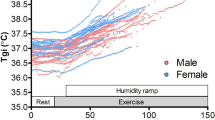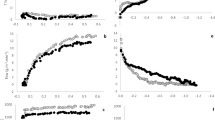Abstract
Obese subjects may be more vulnerable to injury from heat stress, and appear to be less efficient at thermoregulation. Sweat rate, tympanic temperature and osmolality in obese subjects were investigated in Japan during two seasons. The purpose of this study was to examine the relationship between obesity, thermoregulatory response and season. Five obese (BMI, 32.0 ± 4.9 kg/m2) and five non-obese (BMI, 23.2 ± 2.9 kg/m2) men participated in this experiment at latitude 35°10′ N and longitude 136°57.9′E. The average atmospheric temperature was 29.1 ± 1.0 °C in summer and 3.3 ± 1.4 °C in winter. Tympanic temperature and sweat rate were measured during leg water immersion at 42 °C for 30 min. Blood samples were analyzed for plasma osmolality. The relationship between tympanic temperature and sweat rate decreased significantly in obese compared to in non-obese subjects in both seasons, there being a lowered sweat rate for any core temperature in obese subjects. Plasma osmolality was significantly higher in obese than in non-obese subjects in both seasons. Thermal sensation increased significantly in non-obese than in obese in winter but not in summer. Our data show that thermoregulatory responses are attenuated in obese subjects compared with controls, suggesting that obese people are at increased risk of heat-related illnesses.




Similar content being viewed by others
References
Bar-Or O, Lundegren HM, Buskirk ER (1969) Heat tolerance of exercising obese and lean women. J Appl Physiol 26(4):403–409
DuBois D, DuBois EF (1916) A formula to estimate the approximate surface area if height and weight be known. Arch Int Med 17:863–871
Grogan H, Hopkins PM (2002) Heat stroke: implications for critical care and anaesthesia. Br J Anaesth 88(5):700–707
Heikens MJ, Gorbach AM, Eden HS, Savastano DM, Chen KY, Skarulis MC, Yanovski JA (2011) Core body temperature in obesity. Am J Clin Nutr 93(5):963–967
Honma K, Honma S, Kohsaka M, Fukuda N (1992) Seasonal variation in the human circadian rhythm: dissociation between sleep and temperature rhythm. Am J Physiol 262(5 Pt 2):R885–R891
Kanikowska D, Sugenoya J, Sato M, Shimizu Y, Inukai Y, Nishimura N, Iwase S (2010) Influence of season on plasma antidiuretic hormone, angiotensin II, aldosterone and plasma renin activity in young volunteers. Int J Biometeorol 54(3):243–248
Löffler H, Aramaki JU, Effendy I (2002) The influence of body mass index on skin susceptibility to sodium lauryl sulphate. Skin Res Technol 8(1):19–22
Maeda T, Kaneko SY, Ohta M, Tanaka K, Sasaki A, Fukushima T (2006) Risk factors for heatstroke among Japanese forestry workers. J Occup Health 48(4):223–229
Ogawa T (1997) Where should core temperature be measured in human experiments? J Human Environ Syst 1:47–55
Robinson S (1942) The effect of body size on energy exchange in work. Am J Physiol 136:363–368
Sato M, Kanikowska D, Iwase S, Shimizu Y, Inukai Y, Nishimura N, Sugenoya J (2009) Effects of encouraged water drinking on thermoregulatory responses after 20 days of head-down bed rest in humans. Int J Biometeorol 53(5):443–449
Sato M, Kanikowska D, Sugenoya J, Inukai Y, Shimizu Y, Nishimura N, Iwase S (2011) Effects of aging on thermoregulatory responses and hormonal changes in humans during the four seasons in Japan. Int J Biometeorol 55(2):229–234
Stookey JD, Barclay D, Arieff A, Popkin BM (2007) The altered fluid distribution in obesity may reflect plasma hypertonicity. Eur J Clin Nutr 61(2):190–199
Sugenoya J, Ogawa T (1985) Characteristics of central sudomotor mechanism estimated by frequency of sweat expulsions. Jpn J Physiol 35(5):783–794
Sugenoya J, Matsumoto T, Nishiyama T, Sakamoto Y (2001) Sympathetic control of sweating and cutaneous active vasodilatation. In: Kosaka M, Sugahara T, Schmidt KL, Simon E (eds) Thermotherapy for neoplasma, inflammation, and pain. Springer, Tokyo, pp 166–181
Touitou Y, Portaluppi F, Smolensky MH, Rensing L (2004) Ethical principles and standards for the conduct of human and animal biological rhythm research. Chronobiol Int 21(1):161–170
Touitou Y, Smolensky MH, Portaluppi F (2006) Ethics, standards, and procedures of animal and human chronobiology research. Chronobiol Int 23(6):1083–1096
Trayhurn P, James WP (1978) Thermoregulation and non-shivering thermogenesis in the genetically obese (ob/ob) mouse. Pflugers Arch 373(2):189–193
WHO (2003) Diet, nutrition and the prevention of chronic diseases: report of a joint WHO/FAO expert consultation. WHO Technical Report Series 916. World Health Organization, Geneva
Acknowledgments
This study was supported by a Grant from the Hori Information Science Promotion Foundation, Japan, 2010 to D.K. and by a Grant from the Aikeikai Foundation, Japan, 2010 to M.S.
Author information
Authors and Affiliations
Corresponding author
Additional information
Contributions
D. Kanikowska and M. Sato contributed equally to this work.
Rights and permissions
About this article
Cite this article
Kanikowska, D., Sato, M., Sugenoya, J. et al. Attenuated thermoregulatory responses with increased plasma osmolality in obese subjects during two seasons. Int J Biometeorol 57, 663–667 (2013). https://doi.org/10.1007/s00484-012-0592-0
Received:
Revised:
Accepted:
Published:
Issue Date:
DOI: https://doi.org/10.1007/s00484-012-0592-0




